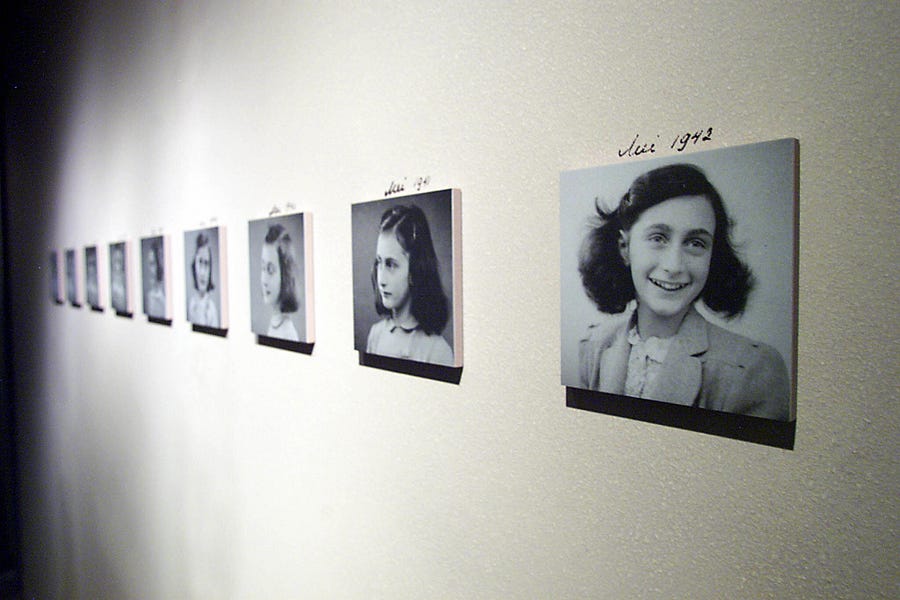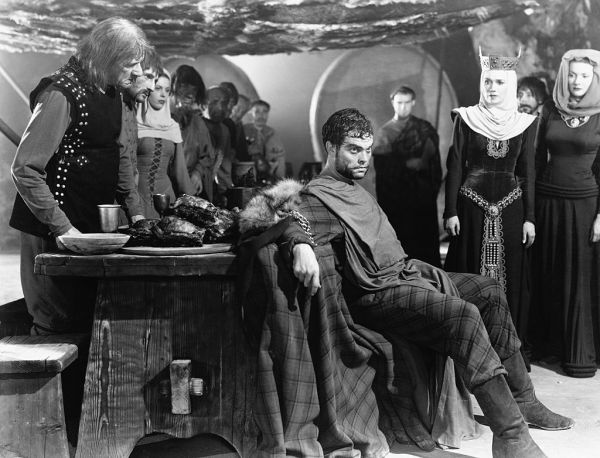It has been 75 years since one of the most beloved books of the 20th century first appeared. Improbably, its author was a teenage girl who initially began writing only for herself, in order to confide her private thoughts to her diary, which she named “Kitty.” The young girl, whose name is now known around the world, was Anne Frank.
The outlines of Anne’s story are familiar even to many who have never read The Diary of a Young Girl. Born in Frankfurt in 1929, she moved to Amsterdam with her family to escape the deteriorating conditions for Jews in Germany. After the Nazi takeover of the Netherlands, Dutch Jews also faced many restrictions. Anne describes them in one of her earliest diary entries: “Jews were required to wear a yellow star; Jews were required to turn in their bicycles; Jews were forbidden to ride in cars, even their own; Jews were required to do their shopping between 3 and 5 p.m.; Jews were required to frequent only Jewish-owned barbershops and beauty parlors;” and so on. When her older sister Margot received a summons to report to a labor camp, Anne’s father, Otto Frank, moved the entire family into hiding, using some rear apartments in his place of business that he had been secretly preparing for just such an emergency.
Together with another family, whom Anne calls the van Daans, the Franks moved into their “secret annex” on July 6, 1942. They were soon joined by a man named Dussel, and the eight residents spent the next two years in their hiding place, where a small group of friends supplied them with food and helped see to their needs. As the war drew toward a close, the Franks eagerly followed news of Allied successes, listening to BBC radio reports of the D-Day invasion of Europe. But with its end finally in sight, and parts of the Netherlands already liberated, the secret annex was discovered. On August 4, 1944, Gestapo agents arrested the Franks. To this day it is unclear whether they were betrayed, or whether something else led to their discovery. They were sent to the German concentration camps, where Anne and Margot died of typhus. Only Otto survived. He dedicated the rest of his life to publishing Anne’s diary as a witness to the horrors of war and the Holocaust.
Anne’s diary has charmed readers ever since its initial publication in 1947. Remarkably, it has been translated from the Dutch into more than 70 languages. Otto initially withheld portions of the diary that were either thought inappropriate (such as descriptions of Anne’s developing sexuality) or that were critical of other family members, especially her mother. Over time, these portions have been restored, with small sections turning up as recently as 1998. Readers can thus enjoy a complete, definitive edition of the text that Anne was already editing with a hope that it might eventually be published, confiding to Kitty that “after the war I’d like to publish a book called The Secret Annex. It remains to be seen whether I’ll succeed, but my diary can serve as the basis.”
The book’s appeal springs from two recurring tensions that underlie Anne’s descriptions of her life in hiding. One is the contrast between the surprisingly normal domesticity of so much of the diary and the wartime conditions that exist outside the annex. We read about mealtimes and schoolwork, lining up for the bathroom and playing with the cat, even birthday celebrations complete with presents. Anne reveals the anxieties that are familiar to any teenager: strained relationships with her parents and sister as she grows more independent, quarrels among the annex residents, an intensifying romantic attraction that Anne feels toward the van Daans’ son Peter, and her worries about whether he returns her affections (her own ardor cools toward the end of the diary). For much of the book one could almost forget that these people are in hiding and cannot even poke their heads out the window lest they be discovered and sent to their death.
But of the course the war and occupation do make their presence felt, and thus we never quite forget the Franks’ perilous situation. On a few occcasions, burglars break into the lower front rooms of the business offices, and Anne describes a night spent in terror that the entrance to their hiding place, carefully concealed behind a specially constructed bookcase, might be discovered. Meals often consist of rotten lettuce, potatoes, spinach, brown beans, or bread. When the man who has been supplying them with potatoes is arrested for hiding Jews in his own home, Anne and the others worry whether they will still have enough to eat at all.
Now and then we also learn what Anne is hearing about life outside the annex. In one early entry, she describes the horrors of Nazi occupation: “At any time of night and day, poor helpless people are being dragged out of their homes. … Families are torn apart; men, women and children are separated. Children come home from school to find that their parents have disappeared.” More than a year later, we read of people turning on each other under the pressure of wartime scarcity: “People have to stand in line to buy vegetables and all kinds of goods; … burglaries and thefts are so common that you ask yourself what’s suddenly gotten into the Dutch to make them so light-fingered. Little children, eight- and eleven-year-olds, smash the windows of people’s homes and steal whatever they can lay their hands on.” Through the window, Anne can see the neighborhood children, who “have no coats, no socks, no caps and no one to help them. Gnawing on a carrot to still their hunger pangs, they walk from their cold houses through cold streets to an even colder classroom.”
Anne’s Jewishness is not a prominent theme in the diary, and indeed the family celebrates St. Nicholas’ Day and Christmas as well as Hanukkah. But of course no Jew at the time, however assimilated, was permitted to forget that she might be marked out for death. At one point Anne asks the agonizing questions, “Who has inflicted this pain on us? Who has set us apart from all the rest? Who has put us through such suffering?” And she wonders whether things can ever be as they were before. “I simply can’t imagine,” she writes, “the world will ever be normal again for us.”
The second tension that lends excitement to the diary arises from Anne’s own vacillating moods, her transitions between joy and despair. As she herself says, “One day we’re laughing at the comical side of life in hiding, and the next day (and there are many such days), we’re frightened.” She worries, of course, about the war, occasionally striking a deeply despondent note: “Jews and Christians alike are waiting, the whole world is waiting, and many are waiting for death.” But the hothouse environment of the secret annex also leads to plenty of more mundane angst. Who among us, even those of us whose teenage years are comfortably in the rearview mirror, would relish the prospect of spending more than two years cooped up in a few small rooms with the same seven people? Little wonder that Anne complains of being misunderstood by her parents, unfairly criticized by the van Daans, and condescended to by Dussel; little wonder that she has trouble connecting with Margot and worries about her relationship with Peter; little wonder that she sometimes feels overwhelmed by anxiety, grief, and fear, rushing to her room to sob alone in her bed.
What is a wonder, however, is that despite all she is enduring—despite war, hunger, and the ever-present possibility of discovery and death—Anne retains, on the whole, a notably sunny and cheerful disposition. Surely this is the secret of the diary’s enduring appeal. “Beauty remains,” she writes, “even in misfortune. If you just look for it, you discover more and more happiness and regain your balance.” Or again: “I don’t have much in the way of money or worldly possessions, I’m not beautiful, intelligent or clever, but I’m happy, and I intend to stay that way! I was born happy, I love people, I have a trusting nature, and I’d like everyone else to be happy too.” Even if there is an element of self-persuasion at work here, the reader can hardly help warming to this brave young woman who in passages like these is almost a poster child for the power of positive thinking.
A few days before the diary breaks off, Anne reflects, “It’s a wonder I haven’t abandoned all my ideals, they seem so absurd and impractical. Yet I cling to them because I still believe, in spite of everything, that people are truly good at heart.” It is sobering to read those words today, with another genocide occurring in Europe and millions of refugees on the run seeking shelter. We might be more likely to agree with Anne’s earlier observation that “there’s a destructive urge in people, the urge to rage, murder and kill.” Perhaps we in the 21st century still need to hear her confident assertion that “I somehow feel that everything will change for the better, that this cruelty too will end, that peace and tranquility will return once more.”
In her entry from April 5, 1944, Anne expresses gratitude to God for her “gift,” the gift of writing, and she wonders, “Will I ever be able to write something great, will I ever become a journalist or a writer? I hope so, oh, I hope so very much.”
Her question has long since been answered. One trusts she knows it. Yes, Anne, you did.








Please note that we at The Dispatch hold ourselves, our work, and our commenters to a higher standard than other places on the internet. We welcome comments that foster genuine debate or discussion—including comments critical of us or our work—but responses that include ad hominem attacks on fellow Dispatch members or are intended to stoke fear and anger may be moderated.